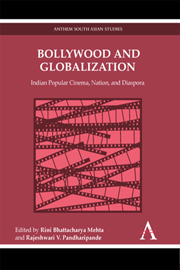Book contents
- Frontmatter
- Contents
- Acknowledgements
- Notes on Contributors
- Chapter One Bollywood, Nation, Globalization: An Incomplete Introduction
- Chapter Two Sentimental Symptoms: The Films of Karan Johar and Bombay Cinema
- Chapter Three Is Everybody Saying ‘Shava Shava’ to Bollywood Bhangra?
- Chapter Four Bollywood Babes: Body and Female Desire in the Bombay Films Since the Nineties and Darr, Mohra and Aitraaz: A Tropic Discourse
- Chapter Five Globalization and the Cultural Imaginary: Constructions of Subjectivity, Freedom & Enjoyment in Popular Indian Cinema
- Chapter Six Rang De Basanti: The Solvent Brown and Other Imperial Colors
- Chapter Seven Between Yaars: The Queering of Dosti in Contemporary Bollywood Films
- Chapter Eight Imagined Subjects: Law, Gender and Citizenship in Indian Cinema
- Chapter Nine ‘It's All About Loving Your Parents’: Liberalization, Hindutva and Bollywood's New Fathers
- Notes
- Select Bibliography
Chapter Eight - Imagined Subjects: Law, Gender and Citizenship in Indian Cinema
Published online by Cambridge University Press: 05 March 2012
- Frontmatter
- Contents
- Acknowledgements
- Notes on Contributors
- Chapter One Bollywood, Nation, Globalization: An Incomplete Introduction
- Chapter Two Sentimental Symptoms: The Films of Karan Johar and Bombay Cinema
- Chapter Three Is Everybody Saying ‘Shava Shava’ to Bollywood Bhangra?
- Chapter Four Bollywood Babes: Body and Female Desire in the Bombay Films Since the Nineties and Darr, Mohra and Aitraaz: A Tropic Discourse
- Chapter Five Globalization and the Cultural Imaginary: Constructions of Subjectivity, Freedom & Enjoyment in Popular Indian Cinema
- Chapter Six Rang De Basanti: The Solvent Brown and Other Imperial Colors
- Chapter Seven Between Yaars: The Queering of Dosti in Contemporary Bollywood Films
- Chapter Eight Imagined Subjects: Law, Gender and Citizenship in Indian Cinema
- Chapter Nine ‘It's All About Loving Your Parents’: Liberalization, Hindutva and Bollywood's New Fathers
- Notes
- Select Bibliography
Summary
‘Integral to heteronormative commercial cinema's creation of desire…women offer a heuristic means to comprehend a film's labored production of a secular, modern society in relation to its internal differences‘
‘[T]he people embed their present in the past’I would like to offer some reflections on imagining a violent history of nation-making in India's cinematic ‘present.’ How do structures of feeling, belief and conflict affect graphing and ‘remembering’ history in Indian cinema? What is the status of the legal, civic or violent ‘event’ – such as the Indian partition of 1947 or the communal riots of increasing frequency since the eighties – in films? What is Indian cinema's imaginary relationship with historiography, and what does it mean to represent an ‘event’ within available ‘structures’ of historic narrative in this cinema frequently described as ‘national’? In discussing the ‘vexed problem of the relation between structure and event,’ and in calling ‘‘structure’ – the symbolic relations of cultural order…an historical object,’ Marshall Sahlins invokes the essential structural backdrop of historical ‘events,’ wherein ‘an event is not simply a phenomenal happening… An event becomes such as it is interpreted. Only as it is appropriated in and through the cultural scheme does it acquire an historical significance… The event is a relation between a happening and a structure (or structures)….’
- Type
- Chapter
- Information
- Bollywood and GlobalizationIndian Popular Cinema, Nation, and Diaspora, pp. 129 - 144Publisher: Anthem PressPrint publication year: 2010



